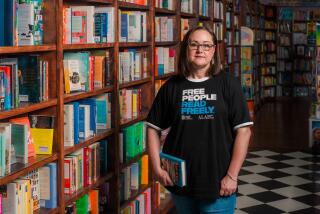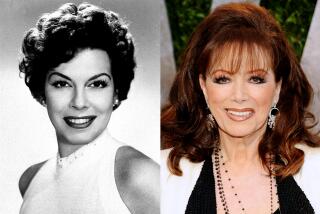Queen of Hearts Keeps Pumping Out Novels of Romance : Books: Barbara Cartland, 89, is the world’s best-selling author, with 515 books to her credit. The former society beauty published her first at 22.
- Share via
HERTFORDSHIRE, ENGLAND — Even for the Queen of Romance, Barbara Cartland’s royal and romantic credentials are unique. The author of hundreds of historical romance novels--in which the girl lands the nobleman and lives happily ever after--lives herself in a fairy-tale-pretty Hertfordshire mansion 20 miles from central London and a stone’s throw from historic Hatfield House, where in 1558 Elizabeth I received the news that she had become Queen of England.
The pair of gold dipped acorns Cartland wears around her neck are from an oak tree in her garden said to have been planted by Elizabeth I and local folklore has it that they’re lucky charms.
On a more contemporary note, Cartland has a future queen practically in the family--her daughter, Raine, is Princess Diana’s step-mother.
One doesn’t so much seek an interview with Barbara Cartland, the world’s best-selling author with a tally of 515 books to her name and sales in nearly 40 countries topping 500 million; rather she grants journalists a tea-time audience.
One approaches through winding, tree-lined country lanes following detailed route instructions faxed by one of Cartland’s four secretaries. “On the left a turquoise blue fence, which is the beginning of the estate . . . turn sharp left through big ornamental gates with a sign that says Camfield Place.”
The two-story, ivy-covered Victorian residence has turquoise painted window frames and an air of romantic tranquillity. The love theme begins with the stone cherubs and Cupids set in the garden on both sides of the sweeping driveway. There are more inside--gilt ones.
Cartland sees journalists in the opulent library where, every afternoon, she reclines on a red velvet sofa and dictates the next 6,500-word chapter of another book to her literary secretary. For 14 years she’s been working this way (“it’s less ponderous than writing”) at the rate of 23 romances a year--a completed novel every two weeks.
A chorus of furious barking from two dogs signals their mistress’s approach. Her labrador is the successor to the one given her by her great friend and cousin of the queen, the late Lord Mountbatten. That dog is immortalized in Madame Tussaud’s Wax Museum in London.
Not that Cartland particularly appreciated the wax sculpture of her darling dog. “They asked me to go and look at him and I said: ‘I think it’s lovely for the chamber of horrors,’ and they wouldn’t speak to me after that,” she said, laughing.
Just past her 89th birthday, she wears her snow-colored hair teased into a candy floss style and staggering false eyelashes that would be considered long on someone a half-century her junior. They’ve become her hallmark.
“When you get older your eyes get smaller so I thought I’d have false eyelashes and they’ve just grown in size. If people don’t like them then they needn’t look,” she said.
A Cartland tour of her house includes the slightly Hollywood-style bedroom with the regal canopied four-poster bed she’s slept in since she married for the first time in 1927. The house was once owned by the father of Beatrix Potter, author of the Peter Rabbit children’s books. “Lord Queenborough had the house before I bought it in 1950,” said Cartland, “and he had two millionairess American wives who put in the parquet flooring and--hold your breath--10 bathrooms. No one had 10 bathrooms in those days--now I’ve got 12.”
Barbara Cartland was born in Birmingham in 1901, and probably got the genes for a full life from both sets of grandparents. Her paternal grandfather helped to build Birmingham during the Industrial Revolution and made and lost a fortune. Her maternal grandfather was one of the first to climb Europe’s highest mountain, Mt. Blanc, and was among the earliest travelers on the Trans-Siberian Railway. She has described her life in five autobiographies and written biographies of her brother and her mother, as well as all the novels.
Cartland published her first novel, “Jigsaw,” when she was 22. She’d always read novels and when she announced to her brothers that she was going to write a book, they said that thanks to her frantic social life she wouldn’t finish it.
She did. “It went into six editions and was translated into five languages. I wrote it all in my own hand, and that was the beginning.”
Her social success gave her entre into journalism when a friend became the social editor of London’s Daily Express. Its owner, the British press baron William Maxwell Aitken, Lord Beaverbrook, asked her to phone in a paragraph the morning after each ritzy party she attended for a fee of five shillings.
“He used to ask me ‘Why have you put the verb here?’ and I hadn’t the slightest idea, (having been) dragged up during the war with half a governess.”
Lord Beaverbrook took the society beauty, then in her 20s, out to dinner with the great names of the day. “I remember they all had this terrific energy. You could feel it vibrating--what Lady Diana Cooper called ‘the odor of genius.’ Max (Beaverbrook) had that about him and, of course, Winston (Churchill). You could feel it.”
Cartland received 49 proposals of marriage before becoming the wife of Scotsman Alexander McCorquodale in 1927. They had daughter Raine and were divorced after six years. She married her first husband’s cousin, Hugh McCorquodale, in 1936 and had two sons. The oldest, Ian is Cartland’s business manager. The second, Glen, is a stockbroker. She is a widow now, and the family remains close with children and grandchildren descending on Camfield Place on weekends.
Cartland realizes that these days, when there’s sex in everything, her novels are slightly out of vogue and laughed gleefully, explaining that when she was invited to present a “Queen of Romance” award to an up-and-coming romantic novelist in America--with the proviso that the heroine must not lose her virginity before marriage--the organizers initially couldn’t find one.
“It was terribly funny. In the end they produced one and the party came off the train singing ‘Hello Barbara, We’re so glad to see you back where you belong,’ to the tune of ‘Hello Dolly.’ ”
Cartland has made pink her color to the extent that people voice disappointment when she wears something else. She has closets full of pink suits, dresses, floating chiffon cocktail numbers and beaded and sequined evening gowns by Norman Hartnell, who also dresses Queen Elizabeth.
Not surprisingly, many of the functions held in her honor include extravagant pink celebrations. When she was presented in 1988 with the Gold Medal of Paris for having sold 25 million books in France, the French capital hosted a fireworks display. The night sky over the Eiffel Tower was lit up with Cartland’s initials and hearts--in a mighty blaze of pink fireworks.
When the National Home Furnishing Assn. in Colorado Springs, Colo., honored her in 1981 for her wallpaper and fabric designs, all the guests at the ceremony turned up in pink to Cartland’s delight. “Some of them hadn’t got anything pink so they wore their bathing clothes. We also had this extraordinary Englishman, who’d found gold in his back garden, and owned 53 Rolls-Royces. He’d had four of them done up in pink with masses of pink flowers--and he wore pink trousers to see us off.”
Underneath the romantic image, Cartland has a variety of activities and is a campaigner for many charitable and political causes. She has lectured all over the world and visited countless orphanages, old people’s homes and refugee camps. She worked in local government and succeeded in getting laws changed to enabled Gypsy children to attend school. She once kept farrowing sows on her farm and set a new record for piglet production. At 77 she recorded her first album--a collection of love songs accompanied by the Royal Philharmonic Orchestra.
Naturally, the Queen of Romance has some advice about love. To remain permanently in love with your spouse, she said, “I’ve always advocated that everyone should have a second honeymoon every year. Leave the children with granny and go somewhere where you can just go to bed and make love. The best time for that is after lunch--which you can only do in France without someone hammering on the door and asking if you’re ill.”
Cartland is deliciously amused by some of her more unlikely reading public. “Very odd people read me, you see. President (Moammar) Kadafi says I’m his favorite author and he gets all my books sent out to Libya from Foyles.” (John Cruikshank, general manager of Foyles, a London bookstore, was unable to verify the Libyan leader’s taste for romance novels. “We have sent books to him in Libya,” he said, “but I can’t confirm or deny that Barbara Cartland novels were included in the order.”)
“When Dickie Mountbatten took one of my books as a present for Mrs. (Jihan) Sadat in Cairo, the then-President (Anwar) Sadat told him that he’d read it first because he was also one of my fans,” Cartland said. “Men read me--particularly lawyers and doctors--because it’s easy. They know that at the end the duke (marries) the girl and they like to see the mess I’ve got him into and how he gets out of it. Fascinating isn’t it? And they’re such nice little stories. It’s extraordinary.”
More to Read
Sign up for our Book Club newsletter
Get the latest news, events and more from the Los Angeles Times Book Club, and help us get L.A. reading and talking.
You may occasionally receive promotional content from the Los Angeles Times.








